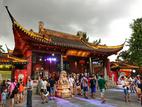China has been working on protecting its important infrastructures, from palaces to temples.
After a few years of renovating and restoring the foundations of the temple, the Puto Zongsheng Temple or the Temple of Potalaka in Heibei province is finally complete on Saturday.
The temple was built in 1771 and its designs are inspired by the Potala Palace in Lhasa, Tibet. It is the largest of 12 satellite temples close to the Mountain Resort or the Chinese Summer Capital in the Qing Dynasty (1644-1912). The Mountain Resort and the temples close to the resort was included in the UNESCO World Heritage List in 1994 and considered the largest surviving royal garden and temple complex in the world, comprising an area of 564 hectares.
According to the director of the Heibei Provincial Administration of Cultural Heritage Zhang Lifang, the restoration of the entire Mountain Complex and its temples started in 2010 and amounted to 600 million yuan in total for all the projects involved in the project.
In the case of the Temple of Potalaka, it included 55 individual construction projects which is far less than the usual constructions for restoration. According to Hebei Ancient Construction Research Institutions expert Sun Yingzhou, this restoration project's hardest part is the copper roof filts with gold since there are no samples the team can use for reference.
Sun also commented "Drainage facility was another key project. Many facilities from Qing Dynasty had been out of repair for long time, and there are many plat rooftops in such Tibetan style constructions. If drainage system doesn't work well, it will be potential hazard for cultural heritage." However, he added that so long as the original facility is still working and only minor restorations needed, they would not touch the drainage system to preserve the location.
Although the main restoration is done, follow-up projects will still continue for the restoration and preservation of other areas such as the decorative paintings of the temple. The team handling these paintings aims to ensure that they would remain as it is and will not have a brand new look.
The restoration completion ceremony of the Temple was done on the 11th Annual National Cultural Heritage Day celebrations on Saturday.









